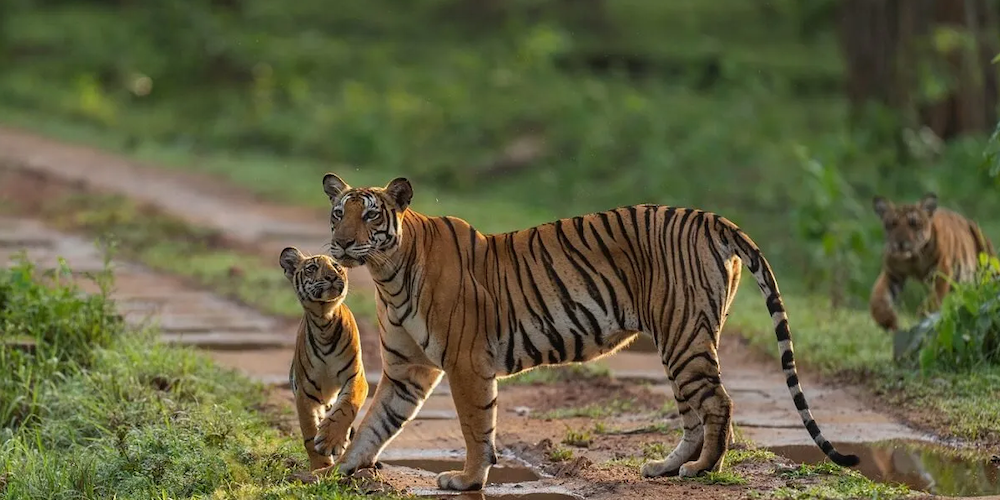Protecting the Wildlife

India boasts 104 national parks, 551 Wildlife Sanctuaries, 131 Marine Protected Areas, 18 Biosphere Reserves, 88 Conservation Reserves and 127 Community Reserves, covering a total of 1,65,088.57 sq km. In total, there are 870 Protected Areas which make 5.06% of the geographical area of the country
India is among the 17 megadiverse countries which together possess 60-70% of world’s biodiversity. The national parks and wildlife reserves in India are home to around 400 species of mammals and 1300+ species of birds.
These wildlife reserves are home to some rare and unique wildlife species like the Indian Sloth Bear, the Chausinga (four-horned antelope) and the Barasinga (swamp deer). In fact, India is the only country where both tigers and lions can be found. It also boasts the highest deer and tiger population in the world.
Along with rich fauna, the Indian wildlife reserves are blessed with abundant flora. There are estimated to be around 15000 species of flowering plants, which make about 6-7% of the world’s total plant species. The Valley of Flowers National Park in Uttarakhand alone boasts 600 species of flowering plants including the famous and exclusive Brahma Kamal.
National Parks and Wildlife Sanctuaries are protected areas declared by Government with the primary objective to preserve wildlife, save flora & fauna and restore the natural ecological balance.
The spectacular natural beauty across the national parks and wildlife sanctuaries in India attracts millions of tourists every year.
There are some basic differences between national park and wildlife sanctuary. The government can declare an area as a national park with adequate ecological, geo-morphological and natural significance. There are no human activities allowed though tourism in certain areas inside the park is allowed.
Removal of forest produce and livestock grazing are strictly prohibited. Wildlife authorities in consultation with the National or State Wildlife Board can undertake such activities. The government can declare an area as a national park with adequate ecological, geo-morphological and natural significance.
Wildlife Sanctuary, on the other hand, is an area demarcated for the protection of a particular species of flora and fauna. Limited human activities may be allowed by the state authorities for the people living inside it. For e.g. Wildlife authorities may allow livestock grazing for a particular community living there.
Any exploitation of wildlife is a punishable offense and removal of forest produce requires a recommendation from the relevant National or State Wildlife Board.

The important steps taken by Government to minimize the human-animal conflict in the country are as follows:
– The Ministry has released species specific guidelines on 21.03.2023 for mitigation of Human –Elephant, -Gaur, -Leopard, -Snake, -Crocodile, -Rhesus Macaque, -Wild Pig, -Bear, -Blue Bull and –Blackbuck Conflict as well as Guidelines for cross cutting issues such as cooperation between the forest and media sector in India; occupational health and safety in the context of human–wildlife conflict mitigation; crowd management in human-wildlife conflict related situations and addressing health emergencies and potential health risks arising out of human-wildlife conflict situations.
– The Ministry of Environment, Forest and Climate Change has issued guidelines to States/UTs on 3rdJune, 2022 for preventing and managing human-wildlife conflict including crop damage caused by wild animals.
– An advisory on dealing with human-wildlife conflict was issued by the Ministry to all States/UTs in February 2021. The advisory recommends coordinated interdepartmental action, identification of conflict hot spots, adherence to Standard Operating Procedures, establishment of rapid response teams, formation of State and District level committees to review the quantum of ex-gratia relief, and prompt payment of relief to affected persons.
– Payment of ex-gratia amount to victims of wild animal attack is provided with a view to reduce human wildlife conflict. The Ministry on 9th February, 2018 enhanced the ex-gratia payment on death from Rs. 2.00 Lakh per person to Rs. 5.00 Lakh per person with increase in amount for ex-gratia in case of injury to human as well.
– The Ministry has issued guidelines for development of linear infrastructure in Wildlife and its adjacent areas to mitigate human –wildlife conflict.
– The Central Government provides financial assistance to State Governments under the Centrally Sponsored Schemes ‘Development of Wildlife Habitats’, ‘Project Tiger’ and ‘Project Elephant’ for management of wildlife and human-wildlife conflict in and around protected areas and conducting awareness campaigns to sensitize and advise the general public.
– The Ministry provides support to State Governments to organize awareness generation, training and capacity building programmes on human-wildlife conflict.
– Advance technology like radio collaring, E-surveillance are also used in human wildlife conflict mitigation.
Management of wildlife is the primarily responsibility of the respective State/Union Territory Governments. Ministry also provides financial assistance to States/UTs under Centrally Sponsored Schemes ‘Development of Wildlife Habitats’ on the basis of Annual Plans of Operation submitted by State/UT Governments for activities like construction/erecting of physical barriers, such as barbed wire fence, solar powered electric fence, bio-fencing using cactus, boundary wall etc.


